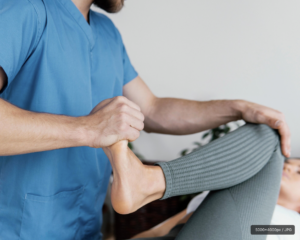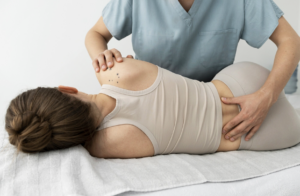The shoulder is an incredibly important and complex part of our anatomy, with muscle attachments from your skull down to your pelvis. The shoulder therefore relies on good spinal posture and stability. Its function is to allow the use of our hand and upper extremity to perform important daily tasks.
Your shoulder is a combination of your humerus (arm), scapular (shoulder blade) and clavicle (collar bone). It is the only joint in the body that has the full 360 degrees of movement. The ball and socket part of the shoulder has very little bone support as the socket is very shallow unlike that of the hip. This means that the shoulder relies heavily on the muscle tissues for movement and stability. The rotator cuff, made up of four muscles, is the deepest muscle layer and acts like a glove that supports the front and back of the ball and socket.
Shoulder pain and dysfunction can be very limiting, and is therefore important to seek professional advice from your Osteopath on what the cause is.
Causes of shoulder pain
– Rotator cuff muscle tendinitis or tear
– Bursitis
– Arthritis of the joint
– Labrum tear
– Shoulder impingement
– A/C (collar bone to shoulder blade) joint sprain or separation
– Frozen shoulder (Adhesive Capsulitis)
– Referred pain from the neck
– Nerve compression
Symptoms of shoulder pain
– There may be pain or discomfort with movements of the shoulder
– Common movements that cause pain are lifting your arm to the side, reaching behind your back
– Pain with overhead movements and activities
– Pain with sleeping on the affected side
– You may notice a rolled forward or hitching on the painful side
– Pain overhead movements
– Pain with reaching, grabbing or lifting with the affected side
– Pain referring down your arm
– Progressively limiting movement
How we can help
Your Osteopath will:
-ask questions about your pain, how it happened, why and when
-thoroughly assess your posture and what movements are painful
-get you to perform basic shoulder tasks
-feel how your shoulder is moving and what muscles are tight, inflamed, or not working properly
-an Osteopath will usually also look and examine your neck, and mid back, as they are important for shoulder function due to many muscles attaching from and to your shoulder from these areas
Diagnosis
-educate you on what is causing your shoulder pain, why it happened and how to fix it
Treatment
– hands on therapy to loosen overly tight muscles
– dry needling can be effective for inflammation relief and decreasing tight muscles
– posture and shoulder position advice for day to day tasks
– exercise rehabilitation to improve muscular strength, mobility and improve the position of your shoulder, ranging from basic to more complex movements and possibly sport or activity specific movements
Your Osteopath at All About Movement will refer you for medical imaging, or to your GP if they feel another opinion, investigations, medications or Specialist referrals are needed. We will also refer to other health professionals for other forms of treatment, so you are getting the best all round care.




